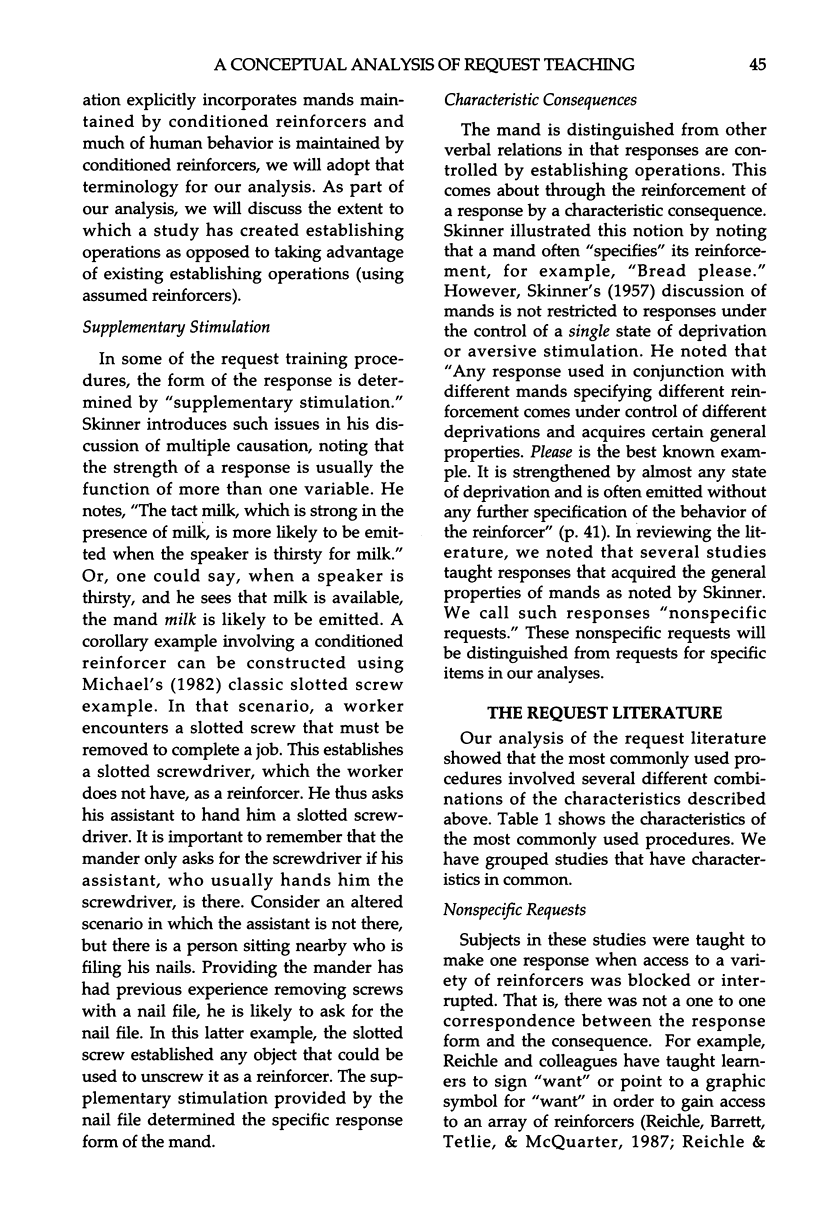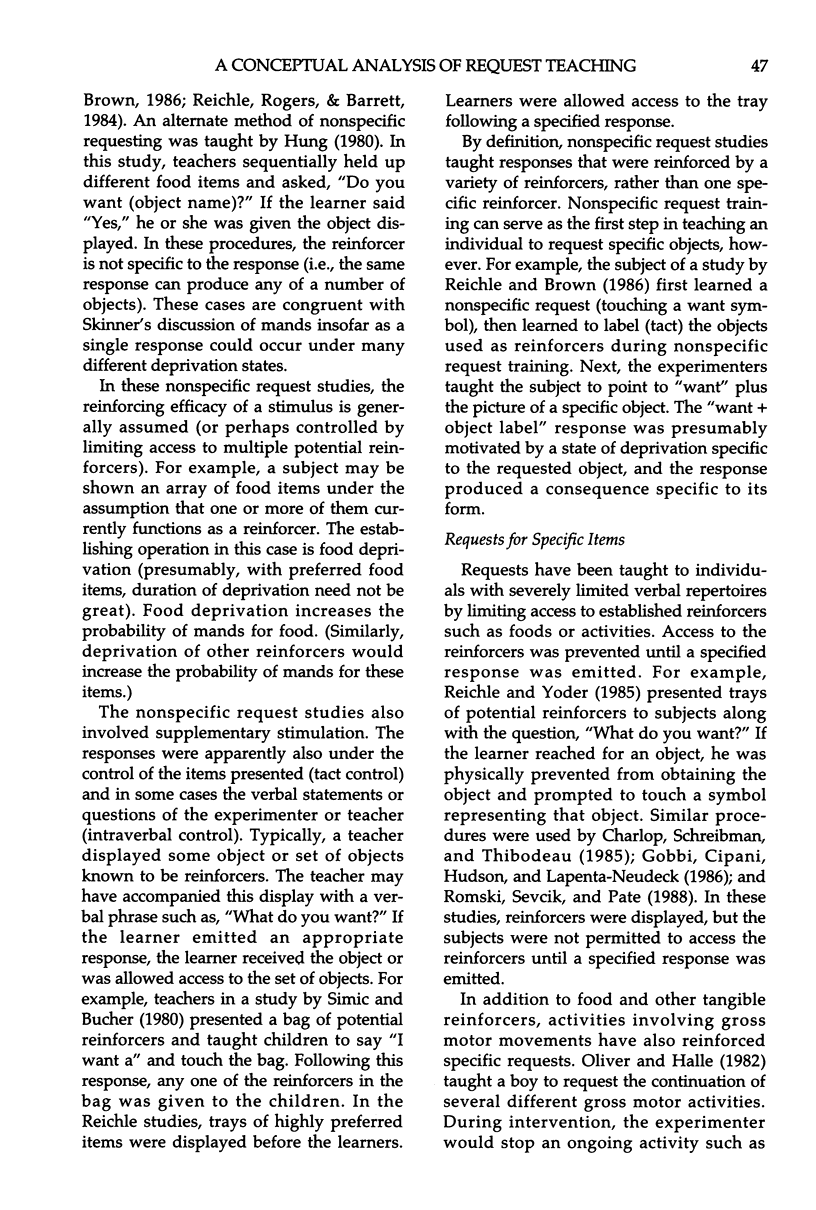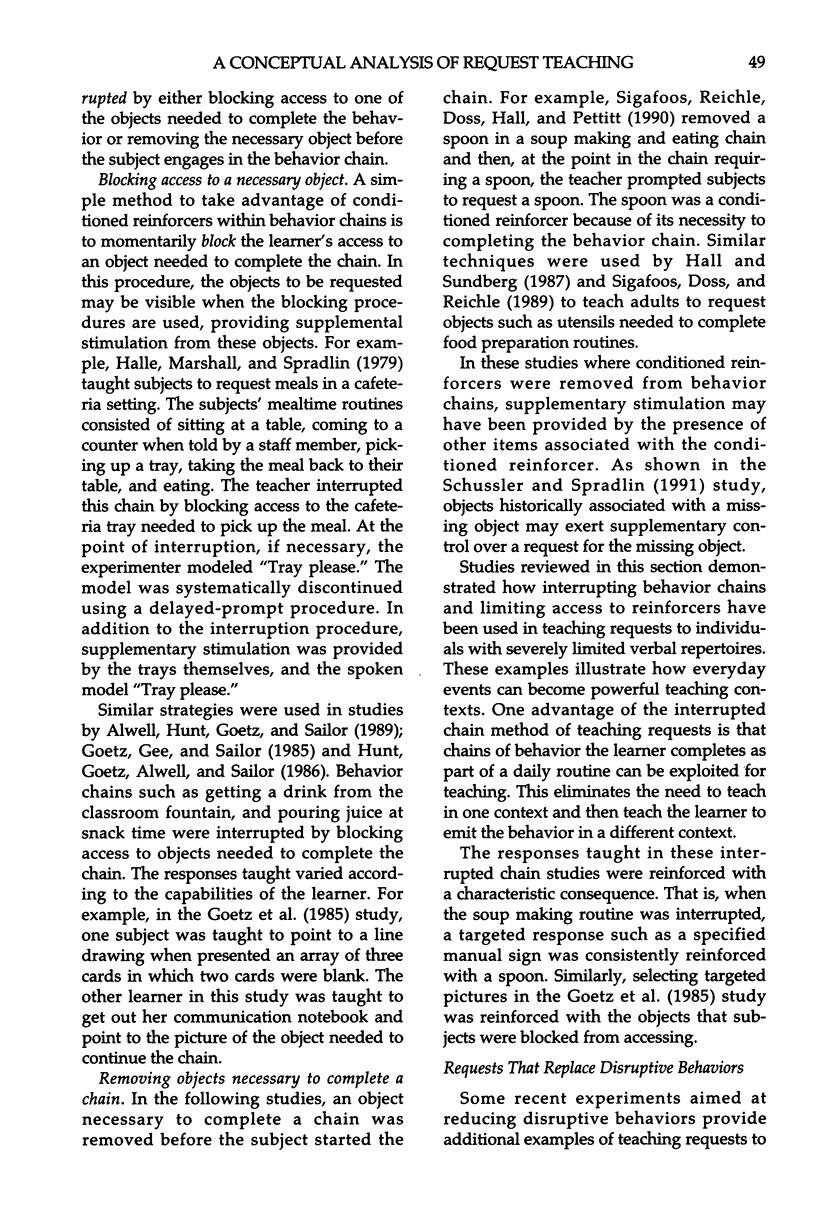Abstract
There have been many published reports of attempts to teach requests to individuals with severely limited verbal repertoires associated with developmental disabilities. Few of these studies used Skinner's (1975) term mand to refer to the behavior taught, yet many seemed to be influenced by Skinner's analysis. We analyzed procedures according to three variables: motivational conditions, supplemental stimulation, and consequences. Individuals with severely limited verbal repertoires provide unique opportunities to study how each of these three variables influence the acquisition of requests. Our analysis indicated that several different procedures were effective in teaching requests, however the degree of supplemental stimulation for the requests varied greatly. Future request teaching programs should consider how each of these three variables influences targeted responses as well as how these variables influence generalization from teaching contexts to nonteaching contexts.
Full text
PDF









Selected References
These references are in PubMed. This may not be the complete list of references from this article.
- Carr E. G., Durand V. M. Reducing behavior problems through functional communication training. J Appl Behav Anal. 1985 Summer;18(2):111–126. doi: 10.1901/jaba.1985.18-111. [DOI] [PMC free article] [PubMed] [Google Scholar]
- Charlop M. H., Schreibman L., Thibodeau M. G. Increasing spontaneous verbal responding in autistic children using a time delay procedure. J Appl Behav Anal. 1985 Summer;18(2):155–166. doi: 10.1901/jaba.1985.18-155. [DOI] [PMC free article] [PubMed] [Google Scholar]
- Gobbi L., Cipani E., Hudson C., Lapenta-Neudeck R. Developing spontaneous requesting among children with severe mental retardation. Ment Retard. 1986 Dec;24(6):357–363. [PubMed] [Google Scholar]
- Halle J. W., Marshall A. M., Spradlin J. E. Time delay: a technique to increase language use and facilitate generalization in retarded children. J Appl Behav Anal. 1979 Fall;12(3):431–439. doi: 10.1901/jaba.1979.12-431. [DOI] [PMC free article] [PubMed] [Google Scholar]
- Hung D. W. Training and generalization of yes and no as mands in two autistic children. J Autism Dev Disord. 1980 Jun;10(2):139–152. doi: 10.1007/BF02408465. [DOI] [PubMed] [Google Scholar]
- Michael J. Distinguishing between discriminative and motivational functions of stimuli. J Exp Anal Behav. 1982 Jan;37(1):149–155. doi: 10.1901/jeab.1982.37-149. [DOI] [PMC free article] [PubMed] [Google Scholar]
- Michael J. Establishing operations. Behav Anal. 1993 Fall;16(2):191–206. doi: 10.1007/BF03392623. [DOI] [PMC free article] [PubMed] [Google Scholar]
- Romski M. A., Sevcik R. A., Pate J. L. Establishment of symbolic communication in persons with severe retardation. J Speech Hear Disord. 1988 Feb;53(1):94–107. doi: 10.1044/jshd.5301.94. [DOI] [PubMed] [Google Scholar]
- Schussler N. G., Spradlin J. E. Assessment of stimuli controlling the requests of students with severe mental retardation during a snack routine. J Appl Behav Anal. 1991 Winter;24(4):791–797. doi: 10.1901/jaba.1991.24-791. [DOI] [PMC free article] [PubMed] [Google Scholar]
- Sigafoos J., Doss S., Reichle J. Developing mand and tact repertoires in persons with severe developmental disabilities using graphic symbols. Res Dev Disabil. 1989;10(2):183–200. doi: 10.1016/0891-4222(89)90006-1. [DOI] [PubMed] [Google Scholar]
- Sigafoos J., Reichle J., Doss S., Hall K., Pettitt L. "Spontaneous" transfer of stimulus control from tact to mand contingencies. Res Dev Disabil. 1990;11(2):165–176. doi: 10.1016/0891-4222(90)90033-5. [DOI] [PubMed] [Google Scholar]
- Simic J., Bucher B. Development of spontaneous manding in language deficient children. J Appl Behav Anal. 1980 Fall;13(3):523–528. doi: 10.1901/jaba.1980.13-523. [DOI] [PMC free article] [PubMed] [Google Scholar]
- Wacker D. P., Steege M. W., Northup J., Sasso G., Berg W., Reimers T., Cooper L., Cigrand K., Donn L. A component analysis of functional communication training across three topographies of severe behavior problems. J Appl Behav Anal. 1990 Winter;23(4):417–429. doi: 10.1901/jaba.1990.23-417. [DOI] [PMC free article] [PubMed] [Google Scholar]


